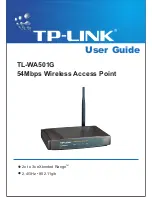
- 21 -
Fragment
Threshold:
The
fragmentation
threshold
is
used
to
set
the
maximum
packets
size
that
a
client
will
send.
The
smaller
the
maximum
sizes
the
better
the
reliability
of
the
wireless
connection,
but
the
performance
is
likely
to
decrease.
Possible
values
range
from
256
to
the
default
value
of
2346
(bytes).
So,
then
when
should
you
change
this
value?
Only
if
you
need
to
improve
the
reliability
of
a
wireless
connection
where
performance
is
secondary.
Usually
you
do
more
harm
than
good
if
you
lower
the
fragment
threshold.
RTS
Threshold:
RTS
(Request
to
send)
packets
are
sent
by
wireless
clients
to
access
points.
The
clients
essentially
ask
for
permission
to
send
the
next
data
packet.
The
lower
the
threshold,
the
more
stable
your
wireless
network,
since
it
essentially
asks
more
often
when
sending
packages.
The
default
value
is
2347,
and
you
are
well
advised
to
leave
this
value
unchanged.
Guard
Interval:
This
option
activates
the
short
guard
interval
(SGI)
when
set
to
400
ns,
which
can
increase
your
wireless
performance
by
up
to
11%.
If
your
wireless
access
point
is
installed
in
a
very
crowded
network
environment
with
different
access
points
occupy
different
channels
all
around
you,
the
slower
guard
interval
of
800
ns
will
provide
better
results.
Space
Time
Block
Coding
(STBC):
STBC
is
an
optional
feature
in
the
802.11n
standard
is
used
to
achieve
the
signal
to
noise
ratio
on
the
RF
receiver.
Reverse
Direction
Grant
(RDG):
Improves
the
efficiency
of
a
two
‐
way
communication.
Enabling
this
is
recommended.
Aggregation
MSDU
(A
‐
MSDU)
and
Auto
Block
ACK:
Every
frame
transmitted
by
an
802.11
device
has
a
significant
amount
of
overhead,
including
radio
level
headers,
Media
Access
Control
(MAC)
frame
fields,
interframe
spacing,
and
acknowledgment
of
transmitted
frames.
At
the
highest
data
rates,
this
overhead
can
consume
more
bandwidth
than
the
payload
data
frame.
To
address
this
issue,
the
802.11n
standard
defines
two
types
of
frame
aggregation:
MAC
Service
Data
Unit
(MSDU)
aggregation
and
MAC
Protocol
Data
Unit
(MPDU)
aggregation.
Both
types
group
several
data
frames
into
one
large
frame.
Because
management
information
needs
to
be
specified
only
once
per
frame,
the
ratio
of
payload
data
to
the
total
volume
of
data
is
higher,
allowing
higher
throughput.
MSDU
aggregation
relies
on
the
fact
that
most
mobile
access
points
and
most
mobile
client
protocol
stacks
use
Ethernet
as
their
"native"
frame
format.
It
collects
Ethernet
frames
to
be
transmitted
to
one
or
multiple
destinations
and
wraps
them
in
a
single
802.11n
frame.
This
is
efficient
because
Ethernet
headers
are
much
shorter
than
802.11
headers.
An
A
‐
MSDU
contains
only
MSDUs
whose
DA
and
SA
parameter
values
map
to
the
same
receiver
address
(RA)
and
transmitter
address
(TA)
values,
i.e.,
all
the
MSDUs
are
intended
to
be
received
by
a
single
receiver,
and
necessarily
they
are
all
transmitted
by
the
same
transmitter.
MPDU
aggregation
also
collects
Ethernet
frames
to
be
transmitted
to
a
single
destination,
but
it
wraps
each
frame
in
an
802.11n
MAC
header.
Normally
this
is
less
efficient
than
MSDU
aggregation,
but
it
may
be
more
efficient
in
environments
with
high
error
rates,
because
of
a
mechanism
called
block
acknowledgement.
This
mechanism
allows
each
of
the
aggregated
data
frames
to
be
individually
acknowledged
or
retransmitted
if
affected
by
an
error.
Decline
BA
Request:
The
Block
ACK
Request
(BAR)
frame
is
sent
prior
to
a
series
of
frames
that
the
transmitter
would
like
to
be
acknowledged.
Without
a
block
ACK
request,
the
receiver
cannot
send
a
block
ACK.
With
this
option
you
can
select
to
either
accept
or
reject
peer
‐
BA
‐
requests.
















































